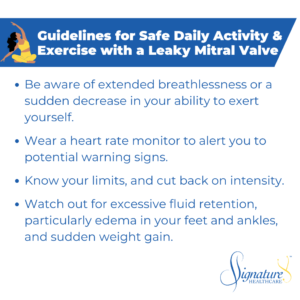What’s the Best Exercise for a Leaky Heart Valve?
Did a physician diagnose you with mitral valve regurgitation?
Did the diagnosis leave you wondering what the best exercise for a leaky heart valve is? Is it safe to work out if you have a diseased valve, and can exercise improve your condition?
Let’s find out.
When a Valve Leaks or Narrows
The cardiovascular system has four valves: the mitral and aortic valves on the left side of the heart and the pulmonic and tricuspid valves on the right.
Heart valve disease occurs when a valve narrows (stenosis) or leaks (regurgitation). Symptomatic disease most commonly occurs in the mitral and aortic valves and less frequently in the tricuspid and pulmonic valves.
A Leaky Mitral Valve Is a “Plumbing” Malfunction
As blood pumps through the heart, the valve between the leftmost chambers doesn’t close completely, allowing blood to leak backward slightly with each heartbeat.
If this leakage becomes pronounced, the patient may become tired or short of breath. If left untreated, severe leakage can damage the heart’s rhythm or cause eventual heart failure.
Valve leakage is on a spectrum and ranked mild, moderate, or severe:
- Mild leakage: Individuals are often unaware of a mildly leaky mitral valve, experiencing no symptoms on an average day.
- Moderate leakage: Patients may experience symptoms such as swelling in their ankles, shortness of breath with physical activities, or fluid retention after eating salty foods.
- Severe leakage: People with severe leakage experience swelling, shortness of breath, and other heart failure warning signs and can’t accomplish normal daily activities.
What Causes Valve Damage?
Poor lifestyle choices don’t cause valve leakage. An individual may be born with a malformed valve. Some people develop calcification on their mitral valve, causing it to deteriorate.
A leaky valve may be a byproduct of rheumatic heart disease earlier in life. Over time, the valve calcifies and wears out.
The risk for mitral valve leakage increases with age. An estimated 10% of people over 75 experience this condition.
You can’t improve valve leakage through exercise, nutrition, or weight change.
Is There a “Best Exercise” for a Leaky Valve?
What’s the best exercise for a leaky heart valve? Is exercise recommended or even safe?
If you are diagnosed with mitral valve regurgitation but want to begin or continue an exercise program, consult your trusted primary care physician for guidance.

Mild to Moderate Leakage
If testing indicates mild to moderate mitral regurgitation, you may tolerate 1A- or 1B-level activity — low-impact, low-exertion activities like bowling, cricket, curling, golf, riflery, or yoga.
Severe Leakage
We typically recommend little or no exertional activity for patients with severe leakage and refer them to a trusted cardiologist to discuss valve replacement or repair.

Monitor Exertion
During your annual physical or office visits at Signature Healthcare, we routinely assess your heart valves’ condition.
We also look for new symptoms, like a lack of energy or a dip in activity tolerance. For example, you may usually run four miles three days a week but suddenly find yourself unable to manage two miles without rest breaks.
If we detect a heart murmur during an exam, we request a noninvasive echocardiogram — an ultrasound of your heart. We measure the valves, observe whether there’s backward flow and how much, and assess your risk/benefit ratio for exercise and other activities.
And if you receive a leaky mitral valve diagnosis, here are some commonsense guidelines to help you get through your day — and workout — safely and effectively:
- Be aware of extended breathlessness or a sudden decrease in your ability to exert yourself, such as experiencing shortness of breath when you lie flat or climb stairs or a hill.
- Wear a heart rate monitor to alert you to potential warning signs, such as a rise in your resting heart rate during minimal activity.
- Know your limits, and cut back on intensity. Avoid level 3 or 4 exertion — vigorous aerobic exercise such as running, skiing, or soccer.
- Watch out for excessive fluid retention, particularly edema in your feet and ankles, and sudden weight gain.
We Take Heart Valve Health Seriously
If you experience a sudden, dramatic change in your tolerance for exercise, it’s time to see your Signature Healthcare doctor.
We monitor our patients for symptoms of valve disease and order echocardiogram testing at scheduled intervals. For a young, healthy patient, this test might occur every couple of years; for an older patient with symptoms, it could happen every six months to a year.
If valve disease is present, we work with you on the best exercise for a leaky (or stenotic) heart valve and an appropriate program to manage it. If damage progresses, we connect you with a respected cardiologist or cardiothoracic surgeon to treat the compromised valve.
When your heart talks, Signature Healthcare listens. Reach out and chat. We can discuss the best exercise for a leaky heart valve.

Michael Warren Smith, MD
Dr. Michael Smith, MD, a dedicated internal medicine specialist, has been serving Charlotte families with distinction for over 19 years. A Wake Forest University alumnus and a devoted family man, Dr. Smith balances his professional life with a passion for golf, beach travels, Peloton rides, and cheering for ACC teams, alongside his wife, Dr. Erin Smith, their two children, and Bogey, their Golden Retriever.

